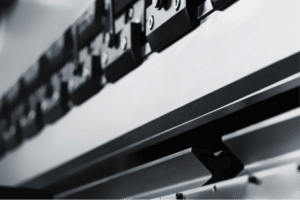Are you looking to add bending capacity to your metal fabrication workshop, or a production facility? You may be stumped about whether or not you should invest in a CNC folder, or a press brake.
Both of these machines are quite expensive, so it’s a good idea to thoroughly consider your options before choosing one over the other. In this article, we’ll discuss both CNC folders and press brakes – and help you decide which one is right for you.

What Is The Difference Between A Press Brake And A CNC Folder?
If you’re not sure what the difference is between a press brake and a CNC folder, let’s break it down for you.
Press brakes use a large, heavy ram, powered either by hydraulics or a mechanical engine, to bend metal that’s pressed against a die. The angle of the die and the power of the ram is what determines the bending angle of the finished product.
Press brakes are used for most metal bending applications, and can be outfitted with backgauges and CNC PLC (programmable logic controllers) to bend an enormous variety of different materials, making them very versatile.
CNC folders are much more specialized than press brakes. Typically, they can only be used to bend materials that are up to 3mm thick, depending on the type of material and the strength of the folder.
Rather than a ram and die, CNC folders clamp or “pinch” materials between an upper “nose bar”, and a lower “beam”. This “beam” swings upward – folding the material along the length of the part.
This process results in a highly-accurate and precise bend. Back gauges and support tables can be used to automate bends, making CNC folders especially popular for applications which require the high-volume bending of thin materials – such as HVAC and the roofing industries.
The Pros And Cons Of Press Brakes
To help you understand what press brakes are good for – and where they fall short – we’ve put together this list of the pros and cons of press brakes, compared to CNC folders.
Pros
- Useful for wider variety of applications
- Can handle thicker materials
- Much more powerful
- Tooling can easily be swapped out for different tooling tasks
Cons
- Two-person operation usually required
- Takes longer for detail work such as small flanges on large sheets
- Large, thin sheets of material are awkward to handle
The Pros And Cons Of CNC Folders
CNC folders are very useful for thinner materials, but they’re not perfect for every application. Here is a list of the advantages and drawbacks of CNC folders.
Pros
- Better at bending highly polished, sensitive or coated materials
- Can be operated by just one person
- Faster and more efficient for thinner metals
- Reduction of manual handling and injury risk
- Better for large, thin sheets
Cons
- Can’t bend thicker materials
- Cannot handle a large variety of bends and tooling tasks
- Expensive for their limited bending capacity
What’s Right For Me?
If your shop specializes in working with thin, lightweight materials, and you are interested in a way to expand your operating capacity, a CNC folder may be right for you. A single CNC folder operator can handle just about every step of the manufacturing process – and because CNC folders do not require retooling for different projects, they offer much more efficient results.
However, if you are interested in a more diverse set of clients, and need a “jack of all trades” bending machine, it’s hard to beat a press brake with a backgauge. Though it usually requires two people to operate, and is less efficient for thinner materials, a press brake will be much more useful for thick materials that a CNC folder cannot handle.
The choice is yours – so think about your current clients and business, and which option is best for your needs.